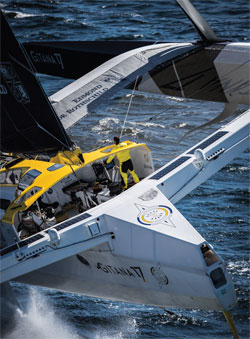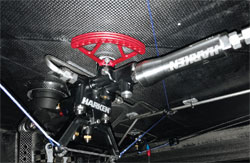

Whether in the Ultim, TP52 or America’s Cup classes, next-generation Harken hydraulics are at the very leading edge of efficiency and reliability
The upcoming 40th anniversary Route du Rhum – Destination Guadeloupe will be an amazing race to follow. Included in the record-size fleet of 122 craft will be the Ultime Edmond de Rothschild – the first ever hydrofoiling maxi trimaran. Great reliability is required in the search for great speed and Harken hydraulics will help lift the maxi tri to new heights as it attempts to foil its way into the record books.
Edmond de Rothschild is a beast of a boat in a performance-orientated way. It measures in at 32m (104ft) LOA with a beam of 23m (75ft) and all-up weight of 15.5 tonnes (33,069 lb). The breathtaking feature of this boat is the pair of 5m (16ft 5in) tall hydrofoils that allow it to “fly” in winds as light as 14kts.
The Route du Rhum – Destination Guadeloupe is a singlehanded race measuring 3,540 nautical miles. Skipper Sébastien Josse will be alone in his pursuit of the race record of seven days, 15 hours (set in the 2014 race). He’ll be helming, navigating, trimming sails and raising and lowering the huge foils all by himself. A properly executed tack or gybe on an Ultime can take up to 45 minutes, at least 20 minutes of which is spent grinding hydraulic functions. It’s a workout fit for the best triathletes, while also requiring the concise decision-making ability of Stephen Hawking.
‘There has never been such a big foiling boat,’ says Edmond de Rothschild’s French designer, Guillaume Verdier. ‘There’s a bit of an unknown relationship as to what the environment will provide us with. It’s nothing like the America’s Cup catamarans, where the foil is piercing the water and the boat is fully out of the water. This kind of thing we will discover at a bigger scale.’
Josse will be aided in his handling of the hydrofoils, rig cant and conventional systems such as mainsheet and outhaul by a slew of hydraulics from Harken, a standard bearer in grand-prix hydraulics and hardware. Harken has been developing its custom hydraulics since the early 2000s and thanks to its exclusive association with the Edmond de Rothschild and in the America’s Cup arena over the past eight years, it has set new standards for performance and reliability. ‘Harken has been developing custom hydraulics for quite a while now,’ said mechanical engineer Ben Biddick, Harken’s lead hydraulics engineer, who works directly with Team Gitana. ‘We’ve focused a lot on weight and compatibility and moving the hydraulic oil from A to B as fast as possible. We gained a lot of knowledge from our exclusive development with Oracle Team USA during the 2013 America’s Cup.’
Harken hydraulics are prominent aboard Edmond de Rothschild, which features 15 Harken cylinders:
- Two cylinders control the maxi trimaran’s shroud tension
- Two cylinders provide daggerboard up/down control
- Two cylinders control the pitch/ rake of the daggerboards
- Two cylinders govern rudder up/ down control
- One cylinder controls the mainsheet, one controls the outhaul
- Five cylinders contribute to foil flap activation.
Some stand-out features of the hydraulics include:
- A throw of 1.8m for the rig cant cylinders, which are located in the amas and integrated into the boat’s structure
- The shortest throw is less than 152mm (6in) for the flap activators
Harken’s exclusive agreement with Team Gitana has seen it involved with the project since the boat was conceptualised in 2013. But its involvement grew stronger last winter after the maxi tri had a refit following last autumn’s Transat Jacque Vabre. Edmond de Rothschild pushes many technical boundaries and it suffered a series of setbacks with its daggerfoils and controlling solenoid valves that prevented it from racing at its full potential. A new, more reliable system was needed to replace the original electrical system.

Above: this beast of a boat is sailed singlehanded by Sébastien Josse, who has to trim the foils and rig cant at the same time as managing all the boat’s conventional systems, plus driving, trimming sails, navigating and running a rigorous maintenance programme. It takes about 45 minutes just to tack or gybe this hugely powerful sailboat.
Below: the complex technology needed to manage all of this raw power is built around no less than 15 next generation hydraulic cylinders that were developed by Harken to the Gitana team’s own very detailed specifications

Harken created a rotary hydraulic pump with three speeds in each direction that results in six distinct levels of fluid distribution.
‘We developed a rotary pump for the 2017 America’s Cup that leveraged well into Edmond de Rothschild’s system,’ says Biddick. ‘The system incorporates mechanisms that shift gears when certain pressures are reached. It’s sort of like making the handles on the pedestal longer and longer as the pressure goes up. Seb has to spin more revolutions for longer periods, but the torque on the handles doesn’t go up.’
Harken worked with Josse to determine a handle spin revolution rate that was most comfortable for him while being sustainable for the time required – somewhere in the range of 40 revolutions per minute. The pump is designed to allow for this consistent pace, increasing the system’s mechanical advantage as the force demands increase. For instance, it might take eight minutes to trim Edmond de Rothschild’s mainsail completely. The last several inches might require the most force, so the boat’s hydraulic system adapts accordingly, to provide more mechanical advantage at the same handle revolution rate. In this way the pump helps to shorten the manoeuvre times by making sure that the human power is used as efficiently as possible.
Last winter Josse, project manager Sebastian Sainson and boat captain David Boileau visited Harken’s world headquarters in Pewaukee, Wisconsin, to gain the hands-on skills needed to tear down each piece of hydraulics and repair them, a measure of self-sufficiency that is important for singlehanded sailing. In addition, Josse spent time on Harken’s hydraulic test bench to determine the optimum spin rate of the handles, experiencing first-hand the designed shift points in the pump system and learning how to use the improved board-control system, both up and down and fore and aft.
‘The cylinders controlling the boards are double-acting: they’re responsible for up and down and hold,’ says Biddick, who has been involved with the project from Day One. ‘The cylinders also integrate into the structural components to make sure the load transfer doesn’t split the boat apart.
‘Primarily, the major development was getting the boards up and down faster, Biddick continues. ‘The original system relied on an electric solenoid valve, but there were problems with the speed and reliability of that system. The new system allows more oil to get through the loop quicker and then the attached flow of water across the board does the work. We focused on the bearing technology inside the daggerboard trunk and by removing the hydraulic constrictions, the board moves itself. We’ve cut the manoeuvre time by 25 per cent. That’s a massive saving when you’re sailing singlehanded.’
Biddick says the pump on Edmond de Rothschild is capable of 350 bar/ 5,000 Psi, a practical limitation given the applications involved. Harken has also developed a pump for use in the grand-prix TP52 Class that is capable of 500 bar/7,500 Psi, a maximum set by the TP52 Class. Harken has manufactured a rotary pump for the TP52s that also is a descendant of its work in the America’s Cup arena.
This pump provides pressure to two hydraulic cylinders. One tensions the headstay and the other tensions the backstay deflector. TP52s don’t have a permanent backstay, so the crews use the deflector when sailing upwind to help maintain headstay tension from the hounds, which are approximately three metres below the masthead. At the windward mark, the tension must be strategically released to counteract the loads from the masthead-flown asymmetric sails.
Harken also designed remote string-controlled release valves with adjustable flow controls to manage cylinder extension speeds. This feature comes into play when the deflector cylinder might need to be released quickly at a windward mark before the A-sail fills, but also allows for gradual manipulation of the headstay cylinder in response to increases in wind strength or changes in sea state that mandate smaller adjustments in sag during a windward leg. By controlling the release valve with a string, crews are able to keep their weight on the windward rail rather than having to reach into the cockpit. These features have greatly simplified the system’s plumbing and weight by reducing the number of fittings and, therefore, potential leak points. Serviceability is also improved.
Harken has designed a new Y control valve to direct the hydraulic fluid to the cylinders. The new valve also has a built-in pressure filter to protect the system from any oil contamination that could occur during installation or from simple mechanical wear. Onboard pressure reliefs are included to protect the two circuits from overload.
Harken continues to keep an eye on the next America’s Cup in 2021 and how its hydraulics and other equipment can best be utilised on the new AC75 Class boat, another hydrofoiling machine with predicted extreme speeds. The new Cup class rule mandates a one-design system for rotating the foil arms, so Harken will concentrate its efforts on the hydraulic actuation and manipulation of the foil flap, wing surface controls and ride management.
Click here for more information on Harken »
We invite you to read on and find out for yourself why Seahorse is the most highly-rated source in the world for anyone who is serious about their racing.
To read on simply SIGN up NOW
Take advantage of our very best subscription offer or order a single copy of this issue of Seahorse.
Online at:
www.seahorse.co.uk/shop and use the code TECH20
Or for iPad simply download the Seahorse App at the iTunes store


